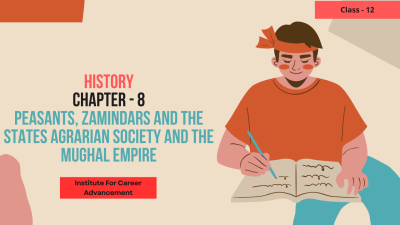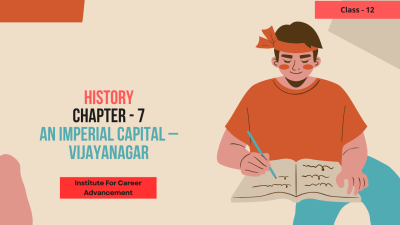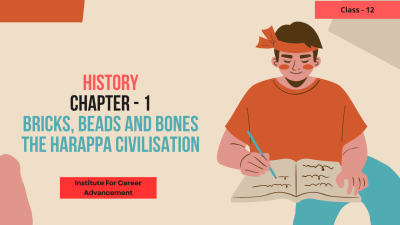Courses


 Compare
Compare
Peasants, Zamindars, and the States: Agrarian Society and the Mughal Empire is a Class 12 chapter that likely explores the agrarian structure of the Mughal Empire and the relationship between peasants, zamindars, and the state. It might delve into topics such as: Land Ownership and Revenue Systems: The different land ownership systems and revenue collection methods employed by the Mughals, including the zamindari system and the ryotwari system. The Role of Peasants: The lives and experiences of peasants, their rights and responsibilities, and the challenges they faced in providing for themselves and their families. The Power of Zamindars: The role of zamindars as intermediaries between the state and the peasants, their power and influence, and the ways in which they could exploit the peasantry. State Policies and Agrarian Reforms: The Mughal Empire's agrarian policies, including land reforms, revenue reforms, and measures to protect the peasantry. Social and Economic Conditions: The social and economic conditions of the peasantry, including their standard of living, access to resources, and vulnerability to exploitation. Overall, this chapter likely provides a comprehensive overview of the agrarian society of the Mughal Empire, the relationships between different social groups, and the challenges and opportunities faced by the peasantry. কৃষক, জমিদার এবং রাজ্যঃ কৃষি সমাজ এবং মুঘল সাম্রাজ্য দ্বাদশ শ্রেণির একটি অধ্যায় যা সম্ভবত মুঘল সাম্রাজ্যের কৃষি কাঠামো এবং কৃষক, জমিদার এবং রাষ্ট্রের মধ্যে সম্পর্কের অন্বেষণ করে। এটি নিম্নলিখিত বিষয়গুলি নিয়ে আলোচনা করতে পারেঃ জমির মালিকানা এবং রাজস্ব ব্যবস্থাঃ জমিদারি ব্যবস্থা এবং রায়তওয়ারি ব্যবস্থা সহ মুঘলদের দ্বারা ব্যবহৃত বিভিন্ন ভূমি মালিকানা ব্যবস্থা এবং রাজস্ব সংগ্রহের পদ্ধতি। কৃষকদের ভূমিকাঃ কৃষকদের জীবন ও অভিজ্ঞতা, তাদের অধিকার ও দায়িত্ব এবং নিজেদের এবং তাদের পরিবারের জন্য সরবরাহ করার ক্ষেত্রে তারা যে চ্যালেঞ্জগুলির মুখোমুখি হয়েছিল। জমিদারদের শক্তিঃ রাষ্ট্র ও কৃষকদের মধ্যে মধ্যস্থতাকারী হিসাবে জমিদারদের ভূমিকা, তাদের ক্ষমতা ও প্রভাব এবং কীভাবে তারা কৃষকদের শোষণ করতে পারে। রাজ্য নীতি ও কৃষি সংস্কারঃ মুঘল সাম্রাজ্যের কৃষি নীতি, যার মধ্যে রয়েছে ভূমি সংস্কার, রাজস্ব সংস্কার এবং কৃষকদের সুরক্ষার ব্যবস্থা। সামাজিক ও অর্থনৈতিক অবস্থাঃ কৃষকদের সামাজিক ও অর্থনৈতিক অবস্থা, যার মধ্যে তাদের জীবনযাত্রার মান, সম্পদের অ্যাক্সেস এবং শোষণের দুর্বলতা রয়েছে। সামগ্রিকভাবে, এই অধ্যায়টি সম্ভবত মুঘল সাম্রাজ্যের কৃষিভিত্তিক সমাজ, বিভিন্ন সামাজিক গোষ্ঠীর মধ্যে সম্পর্ক এবং কৃষকদের সম্মুখীন হওয়া চ্যালেঞ্জ ও সুযোগগুলির একটি বিস্তৃত বিবরণ প্রদান করে।
0 Lessons
Hours

 Compare
Compare
An Imperial Capital: Vijayanagar is a Class 12 chapter that likely explores the history, culture, and architecture of the Vijayanagar Empire, one of the most powerful and influential kingdoms in medieval South India. It might delve into topics such as: The Rise of Vijayanagar: The factors that led to the establishment of the Vijayanagar Empire, its founding rulers, and its expansion. The Vijayanagar Capital: The planning, construction, and architectural features of the Vijayanagar capital, Hampi, which is now a UNESCO World Heritage Site. Economic Prosperity: The Vijayanagar Empire's economic activities, including trade, agriculture, and mining, which contributed to its wealth and power. Cultural Achievements: The Vijayanagar Empire's contributions to art, literature, music, and architecture, reflecting the vibrant and cosmopolitan nature of the kingdom. Religious Tolerance: The Vijayanagar Empire's policy of religious tolerance, which fostered a diverse and multicultural society. Decline and Fall: The factors that led to the decline and eventual fall of the Vijayanagar Empire, including internal conflicts, invasions, and economic difficulties. Overall, this chapter likely provides a comprehensive overview of the Vijayanagar Empire, its historical significance, and its lasting legacy. একটি রাজকীয় রাজধানীঃ বিজয়নগর দ্বাদশ শ্রেণির একটি অধ্যায় যা সম্ভবত মধ্যযুগীয় দক্ষিণ ভারতের অন্যতম শক্তিশালী এবং প্রভাবশালী রাজ্য বিজয়নগর সাম্রাজ্যের ইতিহাস, সংস্কৃতি এবং স্থাপত্যের অন্বেষণ করে। এটি নিম্নলিখিত বিষয়গুলি নিয়ে আলোচনা করতে পারেঃ বিজয়নগরের উত্থানঃ বিজয়নগর সাম্রাজ্যের প্রতিষ্ঠা, এর প্রতিষ্ঠাতা শাসক এবং এর সম্প্রসারণের কারণগুলি। বিজয়নগর রাজধানীঃ বিজয়নগরের রাজধানী হাম্পির পরিকল্পনা, নির্মাণ এবং স্থাপত্য বৈশিষ্ট্য, যা এখন ইউনেস্কোর বিশ্ব ঐতিহ্যবাহী স্থান। অর্থনৈতিক সমৃদ্ধিঃ বিজয়নগর সাম্রাজ্যের বাণিজ্য, কৃষি ও খনি সহ অর্থনৈতিক কার্যক্রম, যা এর সম্পদ ও শক্তিতে অবদান রেখেছিল। সাংস্কৃতিক সাফল্যঃ শিল্প, সাহিত্য, সঙ্গীত এবং স্থাপত্যের ক্ষেত্রে বিজয়নগর সাম্রাজ্যের অবদান রাজ্যের প্রাণবন্ত এবং বিশ্বজনীন প্রকৃতিকে প্রতিফলিত করে। ধর্মীয় সহনশীলতাঃ বিজয়নগর সাম্রাজ্যের ধর্মীয় সহনশীলতার নীতি, যা একটি বৈচিত্র্যময় এবং বহুসংস্কৃতির সমাজকে উৎসাহিত করেছিল। পতন এবং পতনঃ অভ্যন্তরীণ দ্বন্দ্ব, আক্রমণ এবং অর্থনৈতিক সমস্যা সহ বিজয়নগর সাম্রাজ্যের পতন এবং শেষ পর্যন্ত পতনের কারণগুলি। সামগ্রিকভাবে, এই অধ্যায়টি সম্ভবত বিজয়নগর সাম্রাজ্য, এর ঐতিহাসিক তাৎপর্য এবং এর স্থায়ী উত্তরাধিকার সম্পর্কে একটি বিস্তৃত বিবরণ প্রদান করে।
0 Lessons
Hours

 Compare
Compare
Bhakti-Sufi Traditions: Changes in Religious Beliefs and Devotional Texts is a Class 12 chapter that likely explores the development and influence of Bhakti and Sufi traditions in India. It might delve into topics such as: Bhakti Movement: The rise of the Bhakti movement, its key figures (like Ramananda, Kabir, and Tukaram), and its emphasis on devotion and love for God. Sufism: The mystical branch of Islam, its key figures (like Al-Hallaj and Rumi), and its emphasis on spiritual enlightenment and union with God. Synthesis of Traditions: The ways in which Bhakti and Sufi traditions interacted and influenced each other, leading to the synthesis of Hindu and Islamic ideas. Devotional Texts: The development of new devotional texts, including poetry, songs, and hymns, that expressed the Bhakti and Sufi ideals. Social and Cultural Impact: The impact of Bhakti and Sufi traditions on Indian society and culture, including changes in religious practices, social hierarchies, and artistic expressions. Overall, this chapter likely provides a comprehensive overview of the Bhakti and Sufi traditions, their contributions to Indian religious thought, and their influence on the social and cultural landscape of the region. ভক্তি-সুফি ঐতিহ্যঃ ধর্মীয় বিশ্বাস ও ভক্তিমূলক গ্রন্থে পরিবর্তন হল দ্বাদশ শ্রেণির একটি অধ্যায় যা সম্ভবত ভারতে ভক্তি ও সুফি ঐতিহ্যের বিকাশ ও প্রভাব অন্বেষণ করে। এটি নিম্নলিখিত বিষয়গুলি নিয়ে আলোচনা করতে পারেঃ ভক্তি আন্দোলনঃ ভক্তি আন্দোলনের উত্থান, এর মূল ব্যক্তিত্ব (যেমন রামানন্দ, কবির এবং তুকারাম) এবং ঈশ্বরের প্রতি ভক্তি ও ভালবাসার উপর জোর দেওয়া। সুফিবাদঃ ইসলামের রহস্যময় শাখা, এর মূল ব্যক্তিত্ব (যেমন আল-হাল্লাজ এবং রুমি) এবং আধ্যাত্মিক জ্ঞান এবং ঈশ্বরের সাথে মিলনের উপর জোর দেওয়া। ঐতিহ্যের সংশ্লেষঃ ভক্তি এবং সুফি ঐতিহ্যগুলি যেভাবে একে অপরের সাথে মিথস্ক্রিয়া করে এবং একে অপরকে প্রভাবিত করে, যা হিন্দু ও ইসলামী ধারণার সংশ্লেষণের দিকে পরিচালিত করে। ভক্তিমূলক গ্রন্থঃ কবিতা, গান এবং স্তব সহ নতুন ভক্তিমূলক গ্রন্থের বিকাশ, যা ভক্তি এবং সুফি আদর্শকে প্রকাশ করে। সামাজিক ও সাংস্কৃতিক প্রভাবঃ ধর্মীয় অনুশীলন, সামাজিক শ্রেণিবিন্যাস এবং শৈল্পিক অভিব্যক্তির পরিবর্তন সহ ভারতীয় সমাজ ও সংস্কৃতিতে ভক্তি ও সুফি ঐতিহ্যের প্রভাব। সামগ্রিকভাবে, এই অধ্যায়টি সম্ভবত ভক্তি ও সুফি ঐতিহ্য, ভারতীয় ধর্মীয় চিন্তায় তাদের অবদান এবং এই অঞ্চলের সামাজিক ও সাংস্কৃতিক প্রেক্ষাপটে তাদের প্রভাব সম্পর্কে একটি বিস্তৃত বিবরণ প্রদান করে।
0 Lessons
Hours

 Compare
Compare
Through the Eyes of Travelers: Perceptions of Society is a Class 12 chapter that likely explores the perspectives and observations of foreign travelers who visited ancient civilizations. It might delve into topics such as: Travel Accounts: The experiences and observations of travelers, including their impressions of the people, customs, and landscapes they encountered. Cultural Exchanges: The ways in which travelers interacted with local populations, exchanged goods and ideas, and contributed to cultural diffusion. Perceptions of Foreigners: The ways in which local people viewed and responded to foreign travelers, including stereotypes, prejudices, and curiosity. The Impact of Travel: The influence of travel on the development of civilizations, including the introduction of new technologies, ideas, and practices. Overall, this chapter likely provides a unique perspective on ancient civilizations by examining them through the eyes of outsiders. It offers insights into cultural exchanges, perceptions, and the impact of foreign contact. ভ্রমণকারীদের চোখের মাধ্যমেঃ সমাজের উপলব্ধি একটি দ্বাদশ শ্রেণির অধ্যায় যা সম্ভবত প্রাচীন সভ্যতা পরিদর্শনকারী বিদেশী ভ্রমণকারীদের দৃষ্টিভঙ্গি এবং পর্যবেক্ষণগুলি অন্বেষণ করে। এটি নিম্নলিখিত বিষয়গুলি নিয়ে আলোচনা করতে পারেঃ ভ্রমণ বিবরণীঃ ভ্রমণকারীদের অভিজ্ঞতা এবং পর্যবেক্ষণ, যার মধ্যে রয়েছে মানুষ, রীতিনীতি এবং প্রাকৃতিক দৃশ্যের প্রতি তাদের অনুভূতি। সাংস্কৃতিক বিনিময়ঃ ভ্রমণকারীরা যেভাবে স্থানীয় জনগণের সঙ্গে ভাববিনিময় করেন, পণ্য ও ধারণা বিনিময় করেন এবং সাংস্কৃতিক প্রসারে অবদান রাখেন। বিদেশীদের উপলব্ধিঃ স্থানীয় লোকেরা যেভাবে বিদেশী ভ্রমণকারীদের প্রতি দৃষ্টিভঙ্গি, কুসংস্কার এবং কৌতূহল সহ প্রতিক্রিয়া দেখায়। ভ্রমণের প্রভাবঃ নতুন প্রযুক্তি, ধারণা এবং অনুশীলনের প্রবর্তন সহ সভ্যতার বিকাশে ভ্রমণের প্রভাব। সামগ্রিকভাবে, এই অধ্যায়টি সম্ভবত বহিরাগতদের দৃষ্টিতে পরীক্ষা করে প্রাচীন সভ্যতার উপর একটি অনন্য দৃষ্টিভঙ্গি প্রদান করে। এটি সাংস্কৃতিক বিনিময়, উপলব্ধি এবং বিদেশী যোগাযোগের প্রভাব সম্পর্কে অন্তর্দৃষ্টি প্রদান করে।
0 Lessons
Hours

 Compare
Compare
Thinkers, Beliefs, and Buildings: Cultural Developments is a Class 12 chapter that likely explores the intellectual, religious, and artistic aspects of ancient civilizations. It might delve into topics such as: Philosophical and Religious Thought: The ideas and beliefs of prominent thinkers and philosophers, the development of major religions, and the impact of these beliefs on society. Architectural Marvels: The construction techniques, purpose, and significance of iconic buildings and structures in ancient civilizations. Artistic Expressions: The different forms of art, such as painting, sculpture, and literature, and their cultural significance. Scientific Discoveries: The contributions of ancient civilizations to fields like astronomy, mathematics, and medicine. Cultural Exchange and Diffusion: The ways in which ideas, beliefs, and practices were shared and adopted by different civilizations. Overall, this chapter likely provides a comprehensive overview of the cultural achievements of ancient civilizations, setting the stage for understanding the subsequent development of art, philosophy, religion, and science. চিন্তাবিদ, বিশ্বাস এবং ভবনঃ সাংস্কৃতিক উন্নয়ন হল দ্বাদশ শ্রেণির একটি অধ্যায় যা সম্ভবত প্রাচীন সভ্যতার বুদ্ধিবৃত্তিক, ধর্মীয় এবং শৈল্পিক দিকগুলি অন্বেষণ করে। এটি নিম্নলিখিত বিষয়গুলি নিয়ে আলোচনা করতে পারেঃ দার্শনিক ও ধর্মীয় চিন্তাঃ বিশিষ্ট চিন্তাবিদ ও দার্শনিকদের ধারণা ও বিশ্বাস, প্রধান ধর্মগুলির বিকাশ এবং সমাজে এই বিশ্বাসগুলির প্রভাব। আর্কিটেকচারাল মার্ভেলসঃ প্রাচীন সভ্যতায় আইকনিক বিল্ডিং এবং কাঠামোর নির্মাণ কৌশল, উদ্দেশ্য এবং তাৎপর্য। শৈল্পিক অভিব্যক্তিঃ শিল্পের বিভিন্ন রূপ, যেমন চিত্রকলা, ভাস্কর্য এবং সাহিত্য এবং তাদের সাংস্কৃতিক তাৎপর্য। বৈজ্ঞানিক আবিষ্কারঃ জ্যোতির্বিজ্ঞান, গণিত এবং ওষুধের মতো ক্ষেত্রে প্রাচীন সভ্যতার অবদান। সাংস্কৃতিক বিনিময় এবং বিস্তারঃ বিভিন্ন সভ্যতার মধ্যে ধারণাগুলি, বিশ্বাস এবং অনুশীলনগুলি ভাগ করে নেওয়ার এবং গ্রহণ করার উপায়গুলি। সামগ্রিকভাবে, এই অধ্যায়টি সম্ভবত প্রাচীন সভ্যতার সাংস্কৃতিক সাফল্যের একটি বিস্তৃত বিবরণ প্রদান করে, যা শিল্প, দর্শন, ধর্ম এবং বিজ্ঞানের পরবর্তী বিকাশ বোঝার জন্য মঞ্চ তৈরি করে।
0 Lessons
Hours

 Compare
Compare
Kingship, Caste, and Class: Early Societies is a Class 12 chapter that likely delves into the social and political structures of ancient civilizations. It might explore topics such as: The Rise of Kingship: The factors that led to the emergence of kings and their role in early societies, including maintaining order, managing resources, and representing the community. Caste Systems: The development and functioning of caste systems in ancient civilizations, including the hierarchical structure, rules of endogamy, and the impact on social mobility. Class Structures: The different social classes that existed in early societies, their privileges, and their relationship to the ruling elite and the common people. Social Inequality: The extent of social inequality in early civilizations, including the factors that contributed to it and the ways in which it was maintained or challenged. The Role of Women: The status and roles of women in ancient societies, including their rights, responsibilities, and limitations. Overall, this chapter likely provides a comprehensive overview of the social and political structures that characterized early civilizations, setting the stage for understanding the subsequent development of societies and cultures. রাজত্ব, বর্ণ ও শ্রেণিঃ প্রাথমিক সমাজ হল দ্বাদশ শ্রেণির একটি অধ্যায় যা সম্ভবত প্রাচীন সভ্যতার সামাজিক ও রাজনৈতিক কাঠামো নিয়ে আলোচনা করে। এটি নিম্নলিখিত বিষয়গুলি অন্বেষণ করতে পারেঃ রাজত্বের উত্থানঃ রাজাদের উত্থান এবং শৃঙ্খলা বজায় রাখা, সম্পদ পরিচালনা এবং সম্প্রদায়ের প্রতিনিধিত্ব সহ প্রাথমিক সমাজে তাদের ভূমিকার কারণগুলি। বর্ণ ব্যবস্থাঃ প্রাচীন সভ্যতায় বর্ণ ব্যবস্থার বিকাশ ও কার্যকারিতা, যার মধ্যে রয়েছে শ্রেণিবদ্ধ কাঠামো, অন্তঃবিবাহের নিয়ম এবং সামাজিক গতিশীলতার উপর প্রভাব। শ্রেণী কাঠামোঃ প্রাথমিক সমাজে বিদ্যমান বিভিন্ন সামাজিক শ্রেণী, তাদের সুযোগ-সুবিধা এবং শাসক অভিজাত ও সাধারণ মানুষের সাথে তাদের সম্পর্ক। সামাজিক বৈষম্যঃ প্রাথমিক সভ্যতায় সামাজিক বৈষম্যের পরিমাণ, এতে অবদান রাখা কারণগুলি এবং এটি বজায় রাখা বা চ্যালেঞ্জ করার উপায়গুলি সহ। মহিলাদের ভূমিকাঃ প্রাচীন সমাজে মহিলাদের অধিকার, দায়িত্ব এবং সীমাবদ্ধতা সহ তাদের অবস্থান এবং ভূমিকা। সামগ্রিকভাবে, এই অধ্যায়টি সম্ভবত প্রাথমিক সভ্যতার বৈশিষ্ট্যযুক্ত সামাজিক ও রাজনৈতিক কাঠামোর একটি বিস্তৃত পর্যালোচনা প্রদান করে, যা সমাজ ও সংস্কৃতির পরবর্তী বিকাশ বোঝার জন্য মঞ্চ তৈরি করে।
0 Lessons
Hours

 Compare
Compare
The chapter "Kings, Farmers, and Towns: Early States and Economies" in Class 12 likely explores the emergence and development of early states and their economic systems. It might delve into topics such as: Formation of Early States: The factors that led to the formation of states, including political unification, economic development, and social stratification. Role of Kings and Rulers: The powers and responsibilities of kings and rulers in early states, their role in maintaining order and promoting economic prosperity. Agriculture and Land Ownership: The importance of agriculture as the backbone of early economies, land ownership patterns, and agricultural techniques. Trade and Commerce: The development of trade networks, the role of merchants, and the exchange of goods and ideas. Urbanization and Towns: The growth of towns and cities, their economic functions, and the social and cultural life within them. Economic Systems: Different economic systems that existed in early states, such as barter, tribute, and taxation. Overall, this chapter likely provides a comprehensive overview of the economic and political foundations of early states, setting the stage for understanding the subsequent development of civilizations and empires. দ্বাদশ শ্রেণীর "রাজা, কৃষক ও জনপদঃ প্রারম্ভিক রাজ্য ও অর্থনীতি" অধ্যায়টি সম্ভবত প্রাথমিক রাজ্যগুলির উত্থান ও বিকাশ এবং তাদের অর্থনৈতিক ব্যবস্থার অন্বেষণ করে। এটি নিম্নলিখিত বিষয়গুলি নিয়ে আলোচনা করতে পারেঃ প্রারম্ভিক রাজ্যগুলির গঠনঃ রাজনৈতিক একীকরণ, অর্থনৈতিক উন্নয়ন এবং সামাজিক স্তরবিন্যাস সহ রাজ্য গঠনের কারণগুলি। রাজা ও শাসকদের ভূমিকাঃ প্রাথমিক রাজ্যগুলিতে রাজা ও শাসকদের ক্ষমতা ও দায়িত্ব, শৃঙ্খলা বজায় রাখতে এবং অর্থনৈতিক সমৃদ্ধি বৃদ্ধিতে তাদের ভূমিকা। কৃষি ও জমির মালিকানাঃ প্রাথমিক অর্থনীতি, জমির মালিকানার ধরণ এবং কৃষি কৌশলের মেরুদণ্ড হিসাবে কৃষির গুরুত্ব। বাণিজ্য ও বাণিজ্যঃ বাণিজ্য নেটওয়ার্কের বিকাশ, বণিকদের ভূমিকা এবং পণ্য ও ধারণার বিনিময়। নগরায়ন ও নগরায়নঃ নগর ও নগরের বৃদ্ধি, তাদের অর্থনৈতিক কার্যাবলী এবং তাদের মধ্যে সামাজিক ও সাংস্কৃতিক জীবন। অর্থনৈতিক ব্যবস্থাঃ বিভিন্ন অর্থনৈতিক ব্যবস্থা যা প্রাথমিক রাজ্যগুলিতে বিদ্যমান ছিল, যেমন বিনিময়, কর এবং কর। সামগ্রিকভাবে, এই অধ্যায়টি সম্ভবত প্রাথমিক রাজ্যগুলির অর্থনৈতিক ও রাজনৈতিক ভিত্তির একটি বিস্তৃত পর্যালোচনা প্রদান করে, যা সভ্যতা ও সাম্রাজ্যের পরবর্তী বিকাশ বোঝার জন্য মঞ্চ তৈরি করে।
0 Lessons
Hours

 Compare
Compare
The Harappan Civilization, one of the earliest urban civilizations in the world, flourished along the Indus River Valley in what is now Pakistan and northwestern India. Known for its advanced city planning, sophisticated trade networks, and unique material culture, the Harappan Civilization offers a fascinating glimpse into the past. Key features of the Harappan Civilization include: Urban Planning: The Harappan cities, such as Mohenjo-daro and Harappa, were meticulously planned with grid-like layouts, granaries, and public baths. Material Culture: The Harappans produced a wide range of artifacts, including pottery, seals, jewelry, and tools, made from materials like terracotta, stone, and metal. Trade and Commerce: The Harappans engaged in extensive trade with other civilizations, as evidenced by the presence of foreign goods like lapis lazuli and carnelian. Social Structure: The Harappan society appears to have been hierarchical, with a ruling elite and a large population of artisans, farmers, and laborers. Religious Beliefs: The Harappans had a complex belief system, with evidence of worship of the Mother Goddess and other deities. The Harappan Civilization remains a subject of ongoing research, with many questions about its origins, decline, and cultural influences still unanswered. However, its legacy can be seen in the rich archaeological record and the enduring fascination it continues to hold for scholars and the public alike. বিশ্বের প্রাচীনতম শহুরে সভ্যতাগুলির মধ্যে অন্যতম হরপ্পা সভ্যতা সিন্ধু নদী উপত্যকা বরাবর বর্তমান পাকিস্তান এবং উত্তর-পশ্চিম ভারতে বিকশিত হয়েছিল। উন্নত নগর পরিকল্পনা, পরিশীলিত বাণিজ্য নেটওয়ার্ক এবং অনন্য বস্তুগত সংস্কৃতির জন্য পরিচিত হরপ্পা সভ্যতা অতীতের এক আকর্ষণীয় আভাস দেয়। হরপ্পা সভ্যতার মূল বৈশিষ্ট্যগুলির মধ্যে রয়েছেঃ নগর পরিকল্পনাঃ হরপ্পা শহরগুলি, যেমন মহেঞ্জো-দারো এবং হরপ্পা, গ্রিডের মতো বিন্যাস, শস্যভাণ্ডার এবং জনসাধারণের স্নানাগার দিয়ে নিখুঁতভাবে পরিকল্পনা করা হয়েছিল। বস্তুগত সংস্কৃতিঃ হরপ্পানরা মৃৎশিল্প, সীলমোহর, গহনা এবং টেরাকোটা, পাথর এবং ধাতুর মতো উপকরণ থেকে তৈরি সরঞ্জাম সহ বিভিন্ন ধরনের নিদর্শন তৈরি করত। বাণিজ্য ও বাণিজ্যঃ হরপ্পানরা অন্যান্য সভ্যতার সাথে ব্যাপক বাণিজ্যে জড়িত ছিল, যা ল্যাপিস লাজুলি এবং কার্নেলিয়ানের মতো বিদেশী পণ্যের উপস্থিতি থেকে প্রমাণিত হয়। সামাজিক কাঠামোঃ হরপ্পা সমাজ শ্রেণীবদ্ধ ছিল বলে মনে হয়, যেখানে শাসক অভিজাত এবং কারিগর, কৃষক এবং শ্রমিকদের একটি বড় জনসংখ্যা ছিল। ধর্মীয় বিশ্বাসঃ হরপ্পানদের একটি জটিল বিশ্বাস ব্যবস্থা ছিল, যেখানে মা দেবী এবং অন্যান্য দেবতাদের উপাসনার প্রমাণ ছিল। হরপ্পা সভ্যতা চলমান গবেষণার বিষয় হিসাবে রয়ে গেছে, এর উৎপত্তি, পতন এবং সাংস্কৃতিক প্রভাব সম্পর্কে অনেক প্রশ্নের উত্তর এখনও পাওয়া যায়নি। যাইহোক, এর উত্তরাধিকার সমৃদ্ধ প্রত্নতাত্ত্বিক নথিতে এবং পণ্ডিত এবং জনসাধারণের জন্য এটি অব্যাহত আকর্ষণের মধ্যে দেখা যায়।
0 Lessons
Hours

 Compare
Compare
Paths to Modernization is a course that explores the various pathways that different societies have taken to achieve modernization. It examines the factors that contribute to modernization, such as economic development, technological advancements, political reforms, and social changes. Key topics covered in this course include: Westernization and Modernization: The role of Western influence in the modernization process of non-Western societies. Economic Development and Modernization: The relationship between economic growth, industrialization, and modernization. Technological Advancements and Modernization: The impact of technological innovations on societies and their modernization. Political Reforms and Modernization: The role of political institutions, governance, and democracy in modernization. Social Changes and Modernization: The ways in which social structures, values, and attitudes change as societies modernize. By studying Paths to Modernization, students gain a better understanding of the complex factors that shape the development of societies and the diverse paths that they can take towards modernity. This course also encourages critical thinking and analysis, as students examine the advantages and challenges associated with different modernization models. আধুনিকীকরণের পথ হল এমন একটি পথ যা আধুনিকীকরণ অর্জনের জন্য বিভিন্ন সমাজ যে বিভিন্ন পথ গ্রহণ করেছে তা অন্বেষণ করে। এটি অর্থনৈতিক উন্নয়ন, প্রযুক্তিগত অগ্রগতি, রাজনৈতিক সংস্কার এবং সামাজিক পরিবর্তনের মতো আধুনিকীকরণের ক্ষেত্রে অবদান রাখার কারণগুলি পরীক্ষা করে। এই কোর্সে অন্তর্ভুক্ত মূল বিষয়গুলির মধ্যে রয়েছেঃ পাশ্চাত্যায়ন ও আধুনিকীকরণঃ অ-পাশ্চাত্য সমাজের আধুনিকীকরণ প্রক্রিয়ায় পাশ্চাত্য প্রভাবের ভূমিকা। অর্থনৈতিক উন্নয়ন ও আধুনিকীকরণঃ অর্থনৈতিক প্রবৃদ্ধি, শিল্পায়ন ও আধুনিকীকরণের মধ্যে সম্পর্ক। প্রযুক্তিগত অগ্রগতি এবং আধুনিকীকরণঃ সমাজে প্রযুক্তিগত উদ্ভাবনের প্রভাব এবং তাদের আধুনিকীকরণ। রাজনৈতিক সংস্কার ও আধুনিকীকরণঃ আধুনিকায়নে রাজনৈতিক প্রতিষ্ঠান, শাসন ও গণতন্ত্রের ভূমিকা। সামাজিক পরিবর্তন এবং আধুনিকীকরণঃ সমাজের আধুনিকীকরণের সাথে সাথে সামাজিক কাঠামো, মূল্যবোধ এবং মনোভাবের পরিবর্তন হয়। আধুনিকীকরণের পথগুলি অধ্যয়নের মাধ্যমে, শিক্ষার্থীরা সমাজের বিকাশকে রূপদানকারী জটিল কারণগুলি এবং আধুনিকতার দিকে নিয়ে যেতে পারে এমন বৈচিত্র্যময় পথগুলি সম্পর্কে আরও ভাল ধারণা অর্জন করে। এই কোর্সটি সমালোচনামূলক চিন্তাভাবনা এবং বিশ্লেষণকেও উৎসাহিত করে, কারণ শিক্ষার্থীরা বিভিন্ন আধুনিকীকরণ মডেলের সাথে সম্পর্কিত সুবিধা এবং চ্যালেঞ্জগুলি পরীক্ষা করে।
0 Lessons
Hours